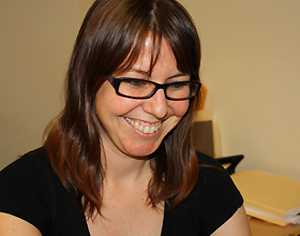Rockin' Researcher
Anthropology alumna Jaime Lennox researches SDSU's rock 'n' roll history.

Anthropologist Jaime Lennox (’05, ’08) has seen her share of excavations.
From desert dunes to the bottoms of abandoned wells and privies, she has uncovered artifacts that have helped shed light on lives lived in previous cultures during past centuries.
These days, however, the 28-year-old assistant coordinator at San Diego’s South Coastal Information Center is engaged in a different sort of digging by delving into library records, private collections and newspaper and magazine archives to find information about rock bands that performed at San Diego State.
What began as research for a possible chapter in a campus history book by Department of Anthropology Chairman Seth Mallios and associate David Caterino (’92) soon took on a life of its own.
“It just keeps getting bigger and bigger the more we find,” said Lennox, who for the past year has been categorizing and cataloging musical acts that have played on campus from the 1930s through 2010.
“It's 2,000 bands, 3,000 concerts and 3,200 individual performances and appearances. That’s a lot and many of those (performers) are very significant.”
So significant that Lennox and Mallios agreed the subject deserves its own book, which they will co-author.
Weird, but fun
Since her first campus concert experience as a student in 2000, Lennox has had a personal interest in rock at SDSU. As an Aztec alum, she is fascinated by the facts she has turned up in her research.
"My favorite part has been compiling the data and then running the analysis on it and seeing things like the fact that over 60 percent of the artists who played here are in halls of fame,” she said.
“I like seeing that and I like seeing that the number of concerts was greatest in the late '70s and early '80s. Why is that? It's because of budget and more student involvement. In those days, bands were booked by students for students before you had outside promoters involved.
“I like looking at the data and being able to answer questions like why we missed the British Invasion. It's because the first rock concert on campus was in '68 and before that it was literally what they called 'formal events' and more traditional artists like Sammy Davis Jr.”
'Shoes are optional'
Lennox said the way for rock at SDSU was paved by folk singers and other popular artists in the early 1960s.
"Julie London was a big draw and Joan Baez in '63, then Bob Dylan in '64,” Lennox noted.
“But Peter, Paul and Mary was the really big one. They needed extra seating in the gym. It was the first time they told people, 'Don't dress up. You can bring a date. You can sit on the floor.’ It wasn't very formal.
"That was a big turning point. Another was the Backdoor — it opened in '69 — and back then shoes were optional. That's what the management said, 'Shoes are optional.' Students could bring beanbag chairs and low-sitting lawn chairs for a concert as long as it didn't block anybody's view.
“One thing I realized with this research is that the campus itself is really special to the San Diego community, especially with the punk movement in the late '70s, early '80s — the Backdoor in particular. It was a very important venue for local bands, for budding musicians or for a movement that was happening with the San Diego community in and of itself. I don't know how else to describe it other than to say these campus venues have served a very important and specific place in San Diego history overall.”
Understanding human behavior
For Lennox, her rock ’n’ roll research provides the perfect opportunity to combine her primary passion, rock music, with her profession.
"Archaeology tries to understand human behavior from culture,” she explained.
“With this project, I'm trying to collect not only that cultural material, but also stories that are part of that culture to help illustrate the fact that rock has contributed to the history of the campus and to the history of San Diego. I guess for some people it might be a stretch to think of it like that, but in reality, that's what it is. Rock was a part of student life and it still is, to some extent.”
That’s why Lennox now seeks input from Aztec alumni and others who have attended rock concerts at SDSU. She is looking for items and memories to back up her research.
"We’re interested in anything you can possibly imagine that would be associated with a (rock) show — anything," she emphasized.
“I would love anybody that was there and has a memory — I don't care what kind of memory it is, just any kind of recollection — to contact me. We're looking for artifacts, specifically the ticket stubs, the T-shirts — I'd love to get a picture of any of that, but really the stories are very important. What happened at the concerts? Did people get to meet the band afterwards? It's the experience of being there — what you remember.”
Lennox still isn’t sure whether the book will be more scholarly or entertaining.
"We're still trying to develop that,” she said. “It's probably going to be a bit of both.”
Given the enthusiasm with which she is approaching her subject, it will almost certainly be absorbing.
If you have photos, artifacts or stories involving a rock performance at San Diego State, please contact Jaime Lennox at [email protected].



